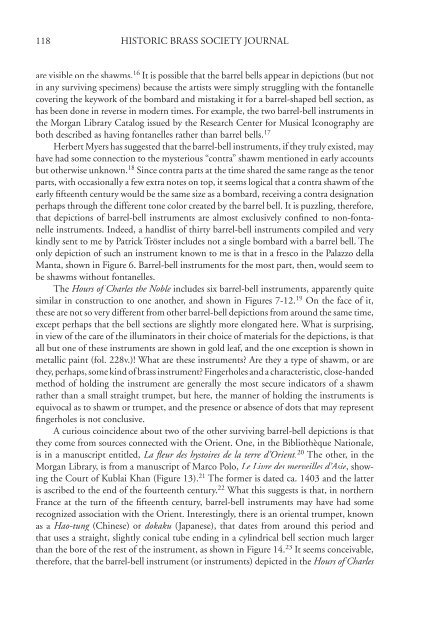backward bells and barrel bells - Historic Brass Society
backward bells and barrel bells - Historic Brass Society
backward bells and barrel bells - Historic Brass Society
You also want an ePaper? Increase the reach of your titles
YUMPU automatically turns print PDFs into web optimized ePapers that Google loves.
118<br />
HISTORIC BRASS SOCIETY JOURNAL<br />
are visible on the shawms. 16 It is possible that the <strong>barrel</strong> <strong>bells</strong> appear in depictions (but not<br />
in any surviving specimens) because the artists were simply struggling with the fontanelle<br />
covering the keywork of the bombard <strong>and</strong> mistaking it for a <strong>barrel</strong>-shaped bell section, as<br />
has been done in reverse in modern times. For example, the two <strong>barrel</strong>-bell instruments in<br />
the Morgan Library Catalog issued by the Research Center for Musical Iconography are<br />
both described as having fontanelles rather than <strong>barrel</strong> <strong>bells</strong>. 17<br />
Herbert Myers has suggested that the <strong>barrel</strong>-bell instruments, if they truly existed, may<br />
have had some connection to the mysterious “contra” shawm mentioned in early accounts<br />
but otherwise unknown. 18 Since contra parts at the time shared the same range as the tenor<br />
parts, with occasionally a few extra notes on top, it seems logical that a contra shawm of the<br />
early fifteenth century would be the same size as a bombard, receiving a contra designation<br />
perhaps through the different tone color created by the <strong>barrel</strong> bell. It is puzzling, therefore,<br />
that depictions of <strong>barrel</strong>-bell instruments are almost exclusively confined to non-fontanelle<br />
instruments. Indeed, a h<strong>and</strong>list of thirty <strong>barrel</strong>-bell instruments compiled <strong>and</strong> very<br />
kindly sent to me by Patrick Tröster includes not a single bombard with a <strong>barrel</strong> bell. The<br />
only depiction of such an instrument known to me is that in a fresco in the Palazzo della<br />
Manta, shown in Figure 6. Barrel-bell instruments for the most part, then, would seem to<br />
be shawms without fontanelles.<br />
The Hours of Charles the Noble<br />
includes six <strong>barrel</strong>-bell instruments, apparently quite<br />
similar in construction to one another, <strong>and</strong> shown in Figures 7-12. 19 On the face of it,<br />
these are not so very different from other <strong>barrel</strong>-bell depictions from around the same time,<br />
except perhaps that the bell sections are slightly more elongated here. What is surprising,<br />
in view of the care of the illuminators in their choice of materials for the depictions, is that<br />
all but one of these instruments are shown in gold leaf, <strong>and</strong> the one exception is shown in<br />
metallic paint (fol. 228v.)! What are these instruments? Are they a type of shawm, or are<br />
they, perhaps, some kind of brass instrument? Fingerholes <strong>and</strong> a characteristic, close-h<strong>and</strong>ed<br />
method of holding the instrument are generally the most secure indicators of a shawm<br />
rather than a small straight trumpet, but here, the manner of holding the instruments is<br />
equivocal as to shawm or trumpet, <strong>and</strong> the presence or absence of dots that may represent<br />
fingerholes is not conclusive.<br />
A curious coincidence about two of the other surviving <strong>barrel</strong>-bell depictions is that<br />
they come from sources connected with the Orient. One, in the Bibliothèque Nationale,<br />
is in a manuscript entitled, La fl eur des hystoires de la terre d’Orient. 20 The other, in the<br />
Morgan Library, is from a manuscript of Marco Polo, Le Livre des merveilles d’Asie, showing<br />
the Court of Kublai Khan (Figure 13). 21 The former is dated ca. 1403 <strong>and</strong> the latter<br />
is ascribed to the end of the fourteenth century. 22 What this suggests is that, in northern<br />
France at the turn of the fifteenth century, <strong>barrel</strong>-bell instruments may have had some<br />
recognized association with the Orient. Interestingly, there is an oriental trumpet, known<br />
as a Hao-tung (Chinese) or<br />
dokaku (Japanese), that dates from around this period <strong>and</strong><br />
that uses a straight, slightly conical tube ending in a cylindrical bell section much larger<br />
than the bore of the rest of the instrument, as shown in Figure 14. 23 It seems conceivable,<br />
therefore, that the <strong>barrel</strong>-bell instrument (or instruments) depicted in the Hours of Charles
















